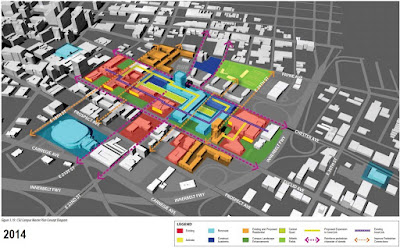As first reported here at NEOtrans last summer, Cleveland State University (CSU) began a search for a consultant to help it design a new downtown campus masterplan. That consultant has been found, with CSU hiring Boston-based Sasaki Associates Inc.
The firm has many campus master-planning efforts on its curriculum vitae. They include for Case Western Reserve University, the Nord Family Greenway in University Circle, Euclid Avenue Healthline Bus Rapid Transit, Lorain Community College buildings in Elyria and North Ridgeville, among many other credits in the USA and around the world.
The masterplan, CSU's first since 2014, will help it continue a decades-long transition from a regional commuter school to more of a nationally prominent residential institution. But this planning effort could also help it determine the placement of and surroundings for future investments in educational and research buildings, athletic facilities, parking and more.
A new wrinkle has been added to the master-planning process -- the long-term impact of the pandemic. With remote learning, some students may wish to continue learning from home, including from several states away. But other students want the campus life, especially an urban campus in an affordable city like Cleveland.
CSU has encouraged the development of more student housing on or near its campus. But that housing has been undertaken by private developers and managed privately. According to sources close to the planning process, CSU appears interested in developing and managing its own student housing.
The university owns and operates only two residence halls -- Fenn Tower and Euclid Commons, totaling 1,039 beds. Both are still relatively new offerings. Fenn Tower is an historic renovation, completed in 2006. Euclid Commons was built new in two phases in 2010-11. CSU rates and plans range from $3,700 per semester to $11,200 per academic year, depending on accommodations.
Those are less expensive than many off-campus housing options, especially as housing in downtown Cleveland gets more expensive. Although the growing interest in micro-units may help to reduce those costs. Those costs are relative, of course, as Cleveland housing costs are less than those of many major cities and urban universities.
CSU would like to take advantage of its urban setting and lower housing costs, hence the interest in developing more on-campus housing. The question for CSU administrators and Sasaki planners is -- where?
One site that may be targeted is the Bert L. and Iris S. Wolstein Center, 2000 Prospect Ave. The 30-year-old, 13,610-seat arena would have hosted thousands of fans cheering the CSU men's basketball team this season, playing its way into the college basketball tournament. Instead, it's hosting thousands of people getting mass-vaccinated to help end the COVID-19 pandemic.
But CSU administrators, including President Harlan Sands, likely won't demolish the center without first consulting with Iris Wolstein. Her late husband Bert who passed away in 2004 was a 1953 graduate of Marshall College of Law which became part of CSU in 1969. Iris Wolstein, now 91, remains active in real estate, serving as president of Heritage Development Co.
 |
| CSU athletic fields dot the east edge of downtown Cleveland, but could be moved eastward toward Interstate 90 to make way for more student housing, as proposed in the last master plan (CSU). |
"President Sands has a great relationship with Iris," said George Kimson Jr., Heritage's chief operating officer. "He's assured her that, as they have news about the center, they would be in contact with her. They've not had discussions with her (about the Wolstein Center) in a few years."
That occasion, in 2016, was a result of the university's last master-planning process. CSU administrators and trustees went out to bid on redeveloping the Wolstein Center site with housing for 1,000 students. That effort was put on hold a year later as the university first wanted to determine whether it should privatize its parking assets.
"They've been around the block a few times on redeveloping the Wolstein Center," Kimson said.
If the Wolstein Center isn't demolished, then administrators and planners may look to the north side of the campus. There are many underutilized properties there which could be developed. Among them are surface parking lots owned by affiliates of Shaia’s Parking Inc. and the Frangos Group.
Principals at both of these local parking lot empires have shown an interest in getting more involved in real estate development, but have few products on the landscape so far. Shaia, in particular, is reportedly promoting the development of townhomes on its parking lots around the Greyhound bus station, 1465 Chester Ave.
 |
| Planners may look at moving the Greyhound bus station to a new site so that the 1948 art deco depot and its surrounding parking lots can be redeveloped with new housing and other uses (KJP). |
The parking firm is also suggesting that the bus station itself be turned into an "entertainment facility," according to preliminary plans circulating among real estate stakeholders. Principal Vic Shaia and his son Paul also touted in 2017 the redevelopment of Ambassador Lanes, 1500 Superior Ave., into a tech hub called The Zeppelin. That project remains undeveloped.
A message left with Vic and Paul Shaia on the contact page of their company's Web site was not returned prior to publication of this article.
Another CSU athletic facility the master plan will likely take a hard look at is Krenzler Field. The soccer and lacrosse field features a removable, air-supported dome. It neighbors on Chester the Viking Softball Field and the Medical Mututal Tennis Pavilion. Krenzler Field was renovated in 2018 for $2.9 million.
But as lacrosse and especially soccer have increased in popularity, including the possibility of a professional outdoor soccer team playing in Cleveland, the 1,500-seat facility may be too small. A larger stadium could be part of the master plan and incorporate facilities for softball and tennis. The 2014 plan had these athletic facilities moved closer to Interstate 90 but, like the Wolstein Center's replacement, it never happened.
END



No comments:
Post a Comment